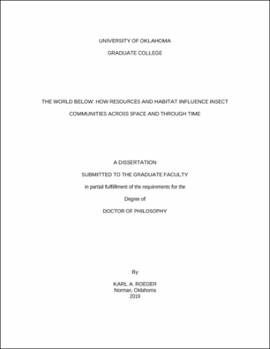| dc.description.abstract | Insects are one of the most abundant, diverse, and ecologically important clades of organisms. They represent up to 5-10 million species, accounting for approximately 46% of the animal biomass on Earth. Yet, despite the importance of insects for terrestrial ecosystems—as consumers, detritivores, herbivores, and predators—little information is known about the natural history of most species and questions remain on how abiotic conditions and biotic interactions between such species structure ecological communities. In this dissertation, I answer four questions using a variety of techniques on ways in which organismal and ecosystem traits influence the spatio-temporal dynamics of insect communities across a variety of scales.
In chapter one, I used elemental and isotopic methods to explore how the invasive red imported fire ant, Solenopsis invicta, achieves its status as a trophic generalist. Across 31 S. invicta nests, I found that colonies ranged from 1°-consumer to 2°-predator, a range equivalent to whole ant communities in agroecosystems, grasslands, remnant woodlands, and tropical rainforests. I found that a colony’s trophic rank was stable throughout multiple sampling events during the year, and that colonies eating at higher trophic levels consumed more C3-based resources. While colony size was not a good predictor of trophic position, individual worker 15N increased with mass. Combined, I show how intraspecific trait variation contributes to the trophic breadth of S. invicta and posit additional hypotheses that may further explain why a colony’s trophic signature varied across space but remained stable over time.
In chapter two, I focused on how one abiotic factor, temperature, regulated the activity of S. invicta and consequently its impact on an urban ant assemblage. I did this by quantifying S. invicta’s ability to outcompete native species for resources across ca. 75% of the hours in a summer day, primarily during the hours that were below its thermal maximum of 49°C. Exclosure experiments revealed that Dorymyrmex flavus, a native ant species with similar body size and thermal tolerance to S. invicta, was competitively suppressed by the invasive, but likely persisted in this habitat due to dietary differences. While thermal and dietary traits were useful in predicting how species coexist in this invaded assemblage, one key to S. invicta’s success is likely its ability to forage in all but six hours of a summer’s day.
In chapter three, I resurveyed 33 ant communities, quantifying 20-year differences in the incidence of 28 genera, toward testing the prediction that genera with higher average thermal limits tended to increase at the expense of those with lower limits. In doing so, I found that average temperatures had increased ~1°C during these 20 years and that about 2/3 of the ant genera had increased in more than half of their communities. Consistent with prediction, we found a positive decelerating relationship between critical thermal maxima (CTmax: the high temperatures at which ants lose muscle control) and the proportion of sites in which a genus had increased. Critical thermal minima (CTmin: the low temperatures at which ants first become inactive), by contrast, was not a useful predictor of change. Thermal functional traits like CTmax have thus proved useful in predicting the supposed “winners and losers” of climate change in this dominant and diverse insect taxon.
In chapter four, I move away from ants and instead search for rules by which organismal traits dictate the abundance and distribution of three common litter invertebrates across six North American forests. I used a novel image analysis method to quantify the abundance and body size distributions of mites, springtails, and spiders in 21-m2 plots per forest. I test three hypotheses finding little support for any relationship between body size or litter depth and abundance, but documenting that abundance regularly constrained species richness ca. 82% of the time, often mediating any effect that body size and litter depth may have had on species richness. My results suggest that body size and habitat space in brown food webs are rarely good predictors of abundance, but that diversity is generally well predicted by abundance. | en_US |

